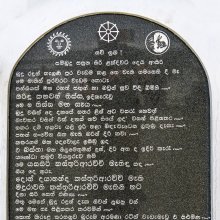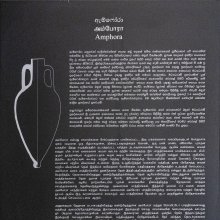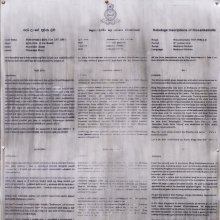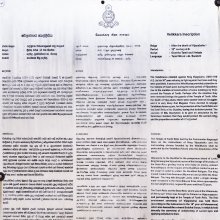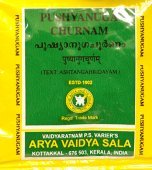Samanga, Samaṃgā, Samamga, Samaṅgā, Samaṅga, Shamanga: 14 definitions
Introduction:
Samanga means something in Buddhism, Pali, Hinduism, Sanskrit, Hindi, biology. If you want to know the exact meaning, history, etymology or English translation of this term then check out the descriptions on this page. Add your comment or reference to a book if you want to contribute to this summary article.
Alternative spellings of this word include Samang.
Images (photo gallery)
In Hinduism
Ayurveda (science of life)
Rasashastra (Alchemy and Herbo-Mineral preparations)
Source: Wisdom Library: Rasa-śāstraSamaṃgā (समंगा):—One of the sixty-eight Rasauṣadhi, very powerful drugs known to be useful in alchemical processes related to mercury (rasa), according to Rasaprakāśa-sudhākara (chapter 9).
Nighantu (Synonyms and Characteristics of Drugs and technical terms)
Source: WorldCat: Rāj nighaṇṭu1) Samaṅgā (समङ्गा) is another name for Balā, a medicinal plant identified with Sida cordifolia Linn. (“country mellow” or “flannel weed”) from the Malvaceae or mallows family of flowering plants, according to verse 4.88-91 of the 13th-century Raj Nighantu or Rājanighaṇṭu. The fourth chapter (śatāhvādi-varga) of this book enumerates eighty varieties of small plants (pṛthu-kṣupa). Together with the names Samaṅgā and Balā, there are a total of twenty-three Sanskrit synonyms identified for this plant.
2) Samaṅgā (समङ्गा) is also mentioned as a synonym for Lajjālu, a medicinal plant identified with Mimosa pudica Linn. or “sensitive plant” from the Fabaceae or “legume” family of flowering plants, according to verse 5.103-106. The fifth chapter (parpaṭādi-varga) of this book enumerates sixty varieties of smaller plants (kṣudra-kṣupa). Together with the names Samaṅgā and Lajjālu, there are a total of twenty-two Sanskrit synonyms identified for this plant.
Kalpa (Formulas, Drug prescriptions and other Medicinal preparations)
Source: Shodhganga: Edition translation and critical study of yogasarasamgrahaSamaṅgā (समङ्गा) refers to the medicinal plant known as “Mimosa pudica Linn.” and is dealt with in the 15th-century Yogasārasaṅgraha (Yogasara-saṅgraha) by Vāsudeva: an unpublished Keralite work representing an Ayurvedic compendium of medicinal recipes. The Yogasārasaṃgraha [mentioning samaṅgā] deals with entire recipes in the route of administration, and thus deals with the knowledge of pharmacy (bhaiṣajya-kalpanā) which is a branch of pharmacology (dravyaguṇa).

Āyurveda (आयुर्वेद, ayurveda) is a branch of Indian science dealing with medicine, herbalism, taxology, anatomy, surgery, alchemy and related topics. Traditional practice of Āyurveda in ancient India dates back to at least the first millenium BC. Literature is commonly written in Sanskrit using various poetic metres.
Purana and Itihasa (epic history)
Source: archive.org: Puranic Encyclopedia1) Samaṅga (समङ्ग).—A cowherd who had been looking after the cattle of Duryodhana. (Mahābhārata Vana Parva, Chapter 289, Verse 2).
2) Samaṅga (समङ्ग).—An ancient hermit. Once this hermit talked to Nārada, about his comfortable life. (Mahābhārata Śānti Parva, Chapter 286, Verse 5).
3) Samaṅgā (समङ्गा).—A river. Because Aṣṭāvakra bathed in this river, his bents were straightened. (See under Aṣṭāvakra).
4) Samaṅga (समङ्ग).—A country in South India. Mention is made about this country in Mahābhārata, Bhīṣma Parva, Chapter 9, Verse 60.
Source: JatLand: List of Mahabharata people and placesSamaṅga (समङ्ग) is a name mentioned in the Mahābhārata (cf. VI.10.59) and represents one of the many proper names used for people and places. Note: The Mahābhārata (mentioning Samaṅga) is a Sanskrit epic poem consisting of 100,000 ślokas (metrical verses) and is over 2000 years old.

The Purana (पुराण, purāṇas) refers to Sanskrit literature preserving ancient India’s vast cultural history, including historical legends, religious ceremonies, various arts and sciences. The eighteen mahapuranas total over 400,000 shlokas (metrical couplets) and date to at least several centuries BCE.
In Buddhism
Theravada (major branch of Buddhism)
Source: Pali Kanon: Pali Proper Names1. The constant attendant of Tissa Buddha. Bu.xviii.21; BuA (p. 191) calls him Samata.
2. See Samagga.
Theravāda is a major branch of Buddhism having the the Pali canon (tipitaka) as their canonical literature, which includes the vinaya-pitaka (monastic rules), the sutta-pitaka (Buddhist sermons) and the abhidhamma-pitaka (philosophy and psychology).
Biology (plants and animals)
Source: Google Books: CRC World Dictionary (Regional names)Samanga in Ivory Coast is the name of a plant defined with Tamarindus indica in various botanical sources. This page contains potential references in Ayurveda, modern medicine, and other folk traditions or local practices It has the synonym Tamarindus erythraeus Mattei (among others).
Example references for further research on medicinal uses or toxicity (see latin names for full list):
· Journal of Economic and Taxonomic Botany (1996)
· Botanical Magazine (4563)
· Boll. Ort. Bot. Palermo (1908)
· Journal of Ethnopharmacology (2006)
· Journal of Ethnopharmacology (2005)
· Proceedings of the Indian Academy of Sciences. Plant Sciences (1990)
If you are looking for specific details regarding Samanga, for example side effects, diet and recipes, chemical composition, extract dosage, pregnancy safety, health benefits, have a look at these references.

This sections includes definitions from the five kingdoms of living things: Animals, Plants, Fungi, Protists and Monera. It will include both the official binomial nomenclature (scientific names usually in Latin) as well as regional spellings and variants.
Languages of India and abroad
Sanskrit dictionary
Source: DDSA: The practical Sanskrit-English dictionarySamaṅgā (समङ्गा).—Bengal madder (mañjiṣṭhā).
Source: Cologne Digital Sanskrit Dictionaries: Shabda-Sagara Sanskrit-English DictionarySamaṅgā (समङ्गा).—f.
(-ṅgā) 1. Bengal madder, (Rubia manjith.) 2. A sort of fern, (Lycopodium imbricatum.) 3. A sort of sensitive plant. E. sam together, agi to go or grow, aff. ac .
Source: Cologne Digital Sanskrit Dictionaries: Cappeller Sanskrit-English DictionarySamaṅga (समङ्ग).—[adjective] having all limbs complete.
Source: Cologne Digital Sanskrit Dictionaries: Monier-Williams Sanskrit-English Dictionary1) Śamāṅga (शमाङ्ग):—[from śama > śam] Name of two places, [Rājataraṅgiṇī]
2) Samaṅga (समङ्ग):—[=sam-aṅga] mf(ā)n. (See 2. sam) having all the limbs, complete, [Atharva-veda] (in, [Mahābhārata] applied to the mythical cow Bahulā)
3) [v.s. ...] m. a kind of game, [cf. Lexicographers, esp. such as amarasiṃha, halāyudha, hemacandra, etc.]
4) [v.s. ...] Name of two men, [Mahābhārata]
5) [v.s. ...] ([plural]) of a people, [ib.]
6) Samaṅgā (समङ्गा):—[=sam-aṅgā] [from sam-aṅga] f. Name of various plants ([according to] to [cf. Lexicographers, esp. such as amarasiṃha, halāyudha, hemacandra, etc.] ‘Rubia Munjista and Cordifolia, Mimosa Pudica, Aloe Indica, etc.’), [Varāha-mihira’s Bṛhat-saṃhitā; Suśruta]
7) [v.s. ...] of a river, [Mahābhārata]
8) Sāmāṅga (सामाङ्ग):—[from sāma > sāman] n. an Aṅga or part of the S°-v°, [Nṛsiṃha-tāpanīya-upaniṣad]
Source: Cologne Digital Sanskrit Dictionaries: Yates Sanskrit-English DictionarySamaṅgā (समङ्गा):—[sama-ṅgā] (ṅgā) 1. f. Bengal madder; sort of fern; sensitive plant.
[Sanskrit to German]
Sanskrit, also spelled संस्कृतम् (saṃskṛtam), is an ancient language of India commonly seen as the grandmother of the Indo-European language family (even English!). Closely allied with Prakrit and Pali, Sanskrit is more exhaustive in both grammar and terms and has the most extensive collection of literature in the world, greatly surpassing its sister-languages Greek and Latin.
Hindi dictionary
Source: DDSA: A practical Hindi-English dictionarySamāṃga (समांग) [Also spelled samang]:—(a) homogeneous; sound; ~[tā] homogeneity; soundness.
...
See also (Relevant definitions)
Partial matches: Nga, Anga, Sam, Cama, Sama, Na.
Starts with: Samamgan, Samangala, Shamangasa.
Ends with: Asamamga, Kshamanga, Mahasamanga.
Full-text: Madhuvila, Samata, Samangin, Cumankai, Samangini, Samang, Kardamilakshetra, Mahasamanga, Phanijihva, Samagga, Shitabala, Ashtavakra, Rasaushadhi, Shambhava, Pulinathupiya, Bhishaj, Lajjalu, Bala, Tissa.
Relevant text
Search found 17 books and stories containing Samanga, Samaṃgā, Samamga, Samaṅgā, Samaṅga, Shamanga, Śamāṅga, Sam-anga, Sam-aṅga, Sam-aṅgā, Sāmāṅga, Sama-nga, Sama-ṅgā, Samāṃga; (plurals include: Samangas, Samaṃgās, Samamgas, Samaṅgās, Samaṅgas, Shamangas, Śamāṅgas, angas, aṅgas, aṅgās, Sāmāṅgas, ngas, ṅgās, Samāṃgas). You can also click to the full overview containing English textual excerpts. Below are direct links for the most relevant articles:
Samkhya thoughts in the Mahabharata (by Shini M.V.)
Samaṅga Nārada Saṃvāda < [Chapter 3 - The Philosophical Tenets in the Śānti-parva]
Atharvaveda and Charaka Samhita (by Laxmi Maji)
Classification of Drugs in the Caraka-Saṃhitā < [Chapter 4 - Diseases and Remedial measures (described in Caraka-saṃhitā)]
Yoga Vasistha [English], Volume 1-4 (by Vihari-Lala Mitra)
Chapter XIII - Consolation of bhrigu < [Book IV - Sthiti prakarana (sthiti prakarana)]
Chapter XVI - Resuscitation of sukra < [Book IV - Sthiti prakarana (sthiti prakarana)]
Chapter XIV - Sukra’s reminiscence of his metempsychosis < [Book IV - Sthiti prakarana (sthiti prakarana)]
Mahabharata (English) (by Kisari Mohan Ganguli)
Section IX < [Jambukhanda Nirmana Parva]
Section CCLXXXVII < [Mokshadharma Parva]
Section CXXXV < [Tirtha-yatra Parva]
The Padma Purana (by N.A. Deshpande)
Chapter 6 - Bhāratavarṣa: Its Rivers and Regions < [Section 3 - Svarga-khaṇḍa (section on the heavens)]
List of Mahabharata people and places (by Laxman Burdak)
Related products
